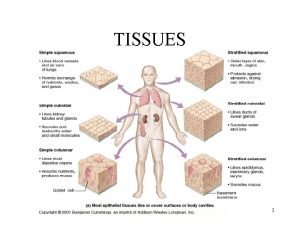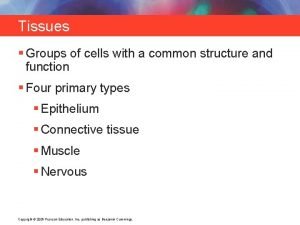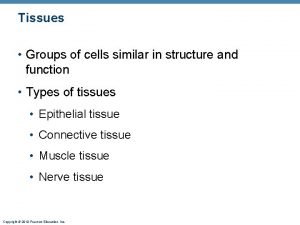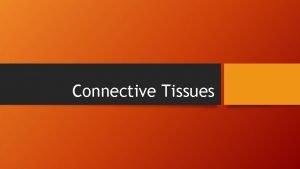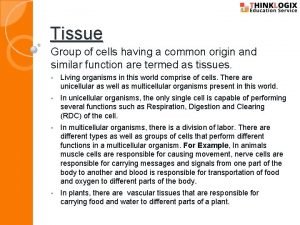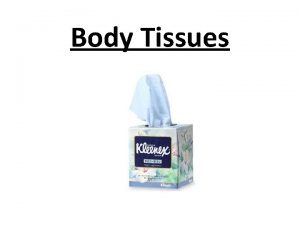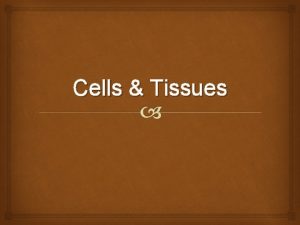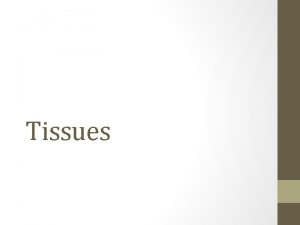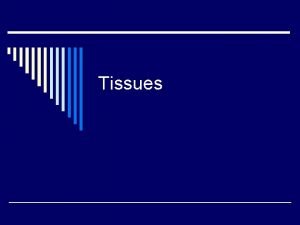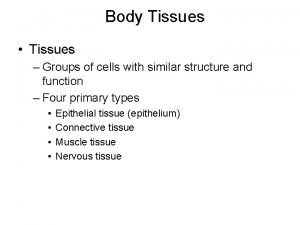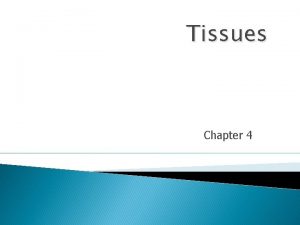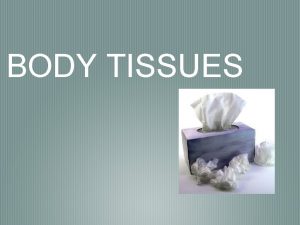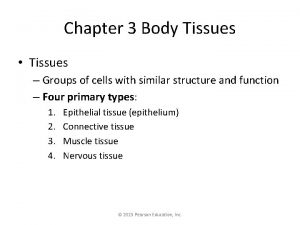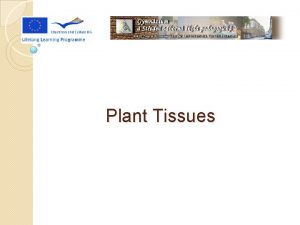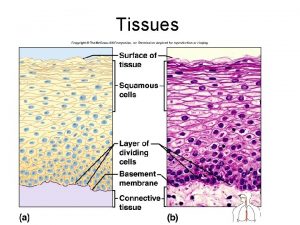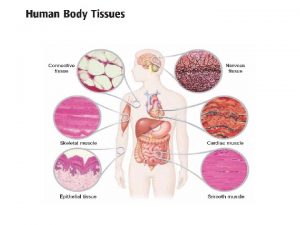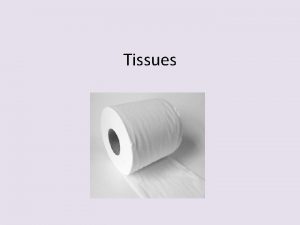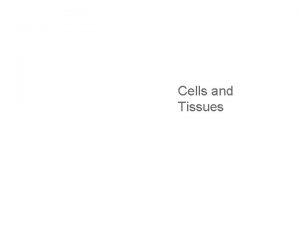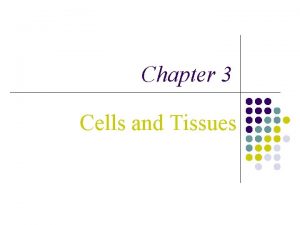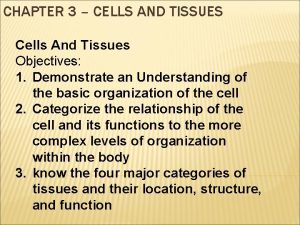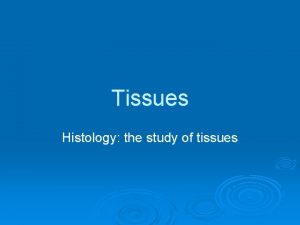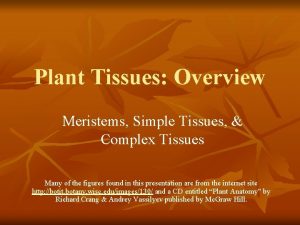Tissues Groups of cells with a common structure






































- Slides: 38

Tissues § Groups of cells with a common structure and function § Four primary types § Epithelium § Connective tissue § Muscle § Nervous Copyright © 2006 Pearson Education, Inc. publishing as Benjamin Cummings.

Epithelial Tissues § Functions: protection, filtration, absorption, secretion § Location: § Line body cavities, cover body surfaces § Glandular epithelia § Exocrine glands: secretion to exterior via ducts § Endocrine glands: secretion directly into blood Copyright © 2006 Pearson Education, Inc. publishing as Benjamin Cummings.

Epithelium Characteristics § Cells fit closely together § always one free surface § lower surface bound by “basement membrane” § Avascular (have no blood supply) § Regenerate easily if well nourished Copyright © 2006 Pearson Education, Inc. publishing as Benjamin Cummings.

Epithelial Tissues: Classification § 1. Cell shape § Squamous: flattened cells § Cuboidal: cube shaped § Columnar: column shaped Copyright © 2006 Pearson Education, Inc. publishing as Benjamin Cummings.

Epithelial Tissues: Classification § Number of cell layers § Simple – one layer § Stratified – more than one layer Copyright © 2006 Pearson Education, Inc. publishing as Benjamin Cummings.

Epithelial Tissues: Attachments § Basement membrane § Structural support, attachment to tissue underneath § Made of secreted proteins Copyright © 2006 Pearson Education, Inc. publishing as Benjamin Cummings.

Attachments: Junctions Between Cells §Tight junctions: nothing passes §Adhesion junctions: some movement between cells §Gap junctions: protein channels Copyright © 2006 Pearson Education, Inc. publishing as Benjamin Cummings. Figure 4. 2

Stratified Epithelium § Stratified squamous § Cells at the free edge are flattened § protective covering where friction is common § Locations § Skin § Mouth § Esophagus Figure 3. 18 e Copyright © 2006 Pearson Education, Inc. publishing as Benjamin Cummings.

Connective Tissue Functions § Binds body tissues together § Supports the body § Provides protection Composed of cells and extracellular matrix: 1. Ground substance of water, proteins and sugars 2. Fibers Copyright © 2006 Pearson Education, Inc. publishing as Benjamin Cummings.

A. Fibrous Connective Tissue § Function: strength and flexibility § Fibers: collagen, elastic, reticular § Matrix: water, polysaccharides, proteins § Cells: fibroblasts, WBCs, fat cells Copyright © 2006 Pearson Education, Inc. publishing as Benjamin Cummings.

A. Fibrous Connective Tissue - 4 types § Loose (areolar): surrounds many organs, lines cavities around blood vessels § Dense: tendons, ligaments, deeper layers of skin Copyright © 2006 Pearson Education, Inc. publishing as Benjamin Cummings.

A. Fibrous Connective Tissue Elastic: surrounds stomach, bladder, maintains shape § Reticular: internal framework of soft organs (liver) and Copyright © 2006 Pearson Education, Inc. publishing as Benjamin Cummings.

B. Special Connective Tissues § Blood: fluid matrix of plasma; red blood cells, white blood cells, and platelets § Adipose tissue: fat cells; function in insulation, protection, and energy storage Copyright © 2006 Pearson Education, Inc. publishing as Benjamin Cummings.

B. Special Connective Tissue § Cartilage: no blood vessels, high collagen content § Bone: inorganic matrix with calcium salts for hardness Copyright © 2006 Pearson Education, Inc. publishing as Benjamin Cummings.

Muscle Tissue: § Skeletal muscle § moves body parts § voluntary, multinucleated § Cardiac muscle § only in the heart § involuntary, single nuclei § Smooth muscle § surrounds hollow Copyright © 2006 Pearson Education, Inc. publishing as Benjamin Cummings.

Nervous Tissue: Transmit Impulses § Neuron: specialized nervous system cell § Structure: cell body, dendrites, axon § Glial cells: support cells to neurons Copyright © 2006 Pearson Education, Inc. publishing as Benjamin Cummings.

Tissue Repair § Regeneration § Replacement of destroyed tissue by the same kind of cells § Fibrosis § Repair by dense fibrous connective tissue (scar tissue) § Determination of method § Type of tissue damaged § Severity of the injury Copyright © 2006 Pearson Education, Inc. publishing as Benjamin Cummings.

The Language of Anatomy: Body Planes Figure 1. 6 Copyright © 2006 Pearson Education, Inc. publishing as Benjamin Cummings.

Anatomical Position or Direction Copyright © 2006 Pearson Education, Inc. publishing as Benjamin Cummings. Figure 4. 9

Tissue Membranes: Line Body Cavities § Body surfaces, cavities are covered by tissue membranes § Composed of tissues (epithelium and connective)* 4 types Copyright © 2006 Pearson Education, Inc. publishing as Benjamin Cummings.

1. Serous Membranes reduce friction between organs § Lines interior body cavities § Serous layers separated by serous fluid Figure 4. 1 c Copyright © 2006 Pearson Education, Inc. publishing as Benjamin Cummings.

Body Cavities Copyright © 2006 Pearson Education, Inc. publishing as Benjamin Cummings. Figure 4. 8

2. Mucous Membranes lubricate surfaces, capture debris § Epithelium (various types) plus loose connective tissue § Lines all body cavities that open to body’s exterior § absorption or secretion Figure 4. 1 b Copyright © 2006 Pearson Education, Inc. publishing as Benjamin Cummings.

3. Synovial Membrane lubricates joints § Connective tissue only § Lines fibrous capsules surrounding joints Figure 4. 2 Copyright © 2006 Pearson Education, Inc. publishing as Benjamin Cummings.

4. Cutaneous Membrane - skin Protective boundary § Epidermis § Keratinized stratified squamous epithelium § Dermis § dense connective tissue Figure 4. 1 a Copyright © 2006 Pearson Education, Inc. publishing as Benjamin Cummings.

Review - Tissue Membranes: § Serous membrane: lines internal cavities § Mucous membrane: lines external cavities § Synovial membrane: lubricate joints § Cutaneous membrane: skin Copyright © 2006 Pearson Education, Inc. publishing as Benjamin Cummings.

Organs and Organ Systems Perform Complex Functions § Organ systems § Groups of organs that perform a common function. § Digestive system: mouth, throat, stomach, intestines, liver § Lymphatic system: lymph nodes, tonsils, spleen Copyright © 2006 Pearson Education, Inc. publishing as Benjamin Cummings.

Homeostasis § Maintenance constant internal conditions § Mechanisms § Negative feedback: deviations from normal detected and counteracted § Components: controlled variable, sensor, control center, effector Copyright © 2006 Pearson Education, Inc. publishing as Benjamin Cummings.

Integumentary System Forms the external body covering § Protects deeper tissue from injury § Synthesizes vitamin D § Location of cutaneous nerve receptors § Aids in heat regulation § Aids in excretion of urea and uric acid Figure 1. 2 a Copyright © 2006 Pearson Education, Inc. publishing as Benjamin Cummings.

Skin: Integumentary System Copyright © 2006 Pearson Education, Inc. publishing as Benjamin Cummings. Figure 4. 10

Appendages of the Skin § Sweat glands § Widely distributed in skin § Eccrine § Open via duct to pore on skin surface § Over entire body § Apocrine § Ducts empty into hair follicles § Axillary, pubic area Copyright © 2006 Pearson Education, Inc. publishing as Benjamin Cummings.

Associated Hair Structures § Hair follicle § Dermal and epidermal sheath surround hair root § Arrector pilli § Smooth muscle § Sebaceous gland (oil) § Sweat gland Figure 4. 7 a Copyright © 2006 Pearson Education, Inc. publishing as Benjamin Cummings.

Appendages of the Skin § Hair § Produced by hair bulb § Consists of hard keratinized epithelial cells § Melanocytes provide pigment for hair color Figure 4. 7 c Copyright © 2006 Pearson Education, Inc. publishing as Benjamin Cummings.

Nail Structures § Free edge § Body § Root of nail § Cuticle proximal nail fold that projects onto the nail body Figure 4. 9 Copyright © 2006 Pearson Education, Inc. publishing as Benjamin Cummings.

Melanin § Pigment (melanin) produced by melanocytes § Color is yellow to brown to black § Melanocytes are mostly in the stratum basale § Amount of melanin produced depends upon genetics and exposure to sunlight Copyright © 2006 Pearson Education, Inc. publishing as Benjamin Cummings.

Skin Cancer Types § Basal cell carcinoma § Least malignant § Most common type § Arises from stratum basale § Squamous cell carcinoma § Arises from stratum spinosum § Metastasizes to lymph nodes § Early removal allows a good chance of cure Copyright © 2006 Pearson Education, Inc. publishing as Benjamin Cummings.

Skin Cancer Types § Malignant melanoma § Most deadly of skin cancers (50% mortality) § Cancer of melanocytes § Metastasizes rapidly to lymph and blood vessels § Detection uses ABCD rule Copyright © 2006 Pearson Education, Inc. publishing as Benjamin Cummings.

ABCD Rule § A = Asymmetry § Two sides of pigmented mole do not match § B = Border irregularity § Borders of mole are not smooth § C = Color § Different colors in pigmented area § D = Diameter § Spot is larger then 6 mm in diameter Copyright © 2006 Pearson Education, Inc. publishing as Benjamin Cummings.
 Body tissues chapter 3 cells and tissues
Body tissues chapter 3 cells and tissues Types of tissue in the body
Types of tissue in the body Body tissues chapter 3 cells and tissues
Body tissues chapter 3 cells and tissues Eisonophil
Eisonophil Stained cheek cell
Stained cheek cell Tissues are groups of similar cells working together to
Tissues are groups of similar cells working together to Tissues are groups of similar cells working together to
Tissues are groups of similar cells working together to A group of cells similar in structure and function
A group of cells similar in structure and function Groups of cells with a common structure and function.
Groups of cells with a common structure and function. Cells-tissues-organ-systems-organism
Cells-tissues-organ-systems-organism Chapter 3 cells and tissues figure 3-7
Chapter 3 cells and tissues figure 3-7 Cell membrane phospholipids
Cell membrane phospholipids Smooth endoplasmic
Smooth endoplasmic A group of cells similar in structure and function
A group of cells similar in structure and function What do all connective tissues have in common
What do all connective tissues have in common How are ethnic groups and religious groups related
How are ethnic groups and religious groups related Waters view with open mouth
Waters view with open mouth Loop of henle
Loop of henle Pineal gland
Pineal gland Gametic cells vs somatic cells
Gametic cells vs somatic cells Why dna is more stable than rna
Why dna is more stable than rna Red blood cells and white blood cells difference
Red blood cells and white blood cells difference Prokaryotic v. eukaryotic cells
Prokaryotic v. eukaryotic cells Venn diagram for animal and plant cells
Venn diagram for animal and plant cells Prokaryotic cells vs eukaryotic cells venn diagram
Prokaryotic cells vs eukaryotic cells venn diagram Why did robert hooke name cells “cells”?
Why did robert hooke name cells “cells”? Masses of cells form and steal nutrients from healthy cells
Masses of cells form and steal nutrients from healthy cells Younger cells cuboidal older cells flattened
Younger cells cuboidal older cells flattened Prokaryotic cells vs eukaryotic cells
Prokaryotic cells vs eukaryotic cells Which organisms are prokaryotes
Which organisms are prokaryotes Nondisjunction in meiosis
Nondisjunction in meiosis Cells cells they're made of organelles meme
Cells cells they're made of organelles meme Protective tissue
Protective tissue Find the common multiples of 12 and 18
Find the common multiples of 12 and 18 Common anode and common cathode
Common anode and common cathode Factor tree of 28
Factor tree of 28 How to find lowest common factor
How to find lowest common factor Greatest common factor and least common multiple
Greatest common factor and least common multiple Highest common factors and lowest common multiples
Highest common factors and lowest common multiples






